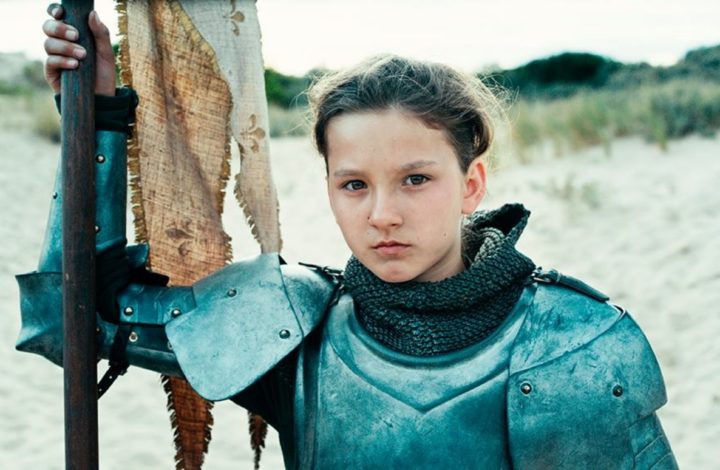
MPAA Rating: NR | Rating: ★★★
Release year: 2019
Genre: Drama, Musical, Spiritual Director: Bruno Dumont
In an stunning sequence in Bruno Dumont’s Jeanne, an armor-clad Joan of Arc (Lise Leplat Prudhomme) is mounted on a horse in the midst of a battlefield between French and English soldiers. The young girl looks surprisingly calm, even majestic. But the battle unfolding is not of massive armies and savage bloodshed. Instead, two rows of horses parade around the verdant open field with balletic grace, accompanied by the rhythmic syncopation from a line of drummers. Beautiful overhead shots capture the symmetry of the riders as they weave around Joan with choreographed movements. A song over the soundtrack sings of battles and God, Euro-pop synths anachronistically supporting the medieval drummers’ cadence. There is something transcendent about this moment in Jeanne, and I confess that I found myself entranced, even moved to tears. Though the entire film is not nearly so affecting, this singular moment had me in its grip.
Bruno Dumont’s earlier film about Joan of Arc, Jeannette: The Childhood of Joan of Arc, appeared on my Top 25 Films of 2018. Where that film was a mashup of mystical theology and heavy metal music as it focused on the early years of Joan’s life and her visions of saints and angels, Jeanne is centered on the battles and trials of the teenage Joan. The visions have ceased, and Joan is now leading the charge of the French army, while the English and Burgundians seek to capture her. Where Jeanne Voisin portrayed the adolescent Joan in the first film, the young Prudhomme (who played 8-year-old Joan in the earlier film) is now in the role of a young woman. The casting choice is striking, as it puts a child on trial before the quorum of clergy, all elderly men in extravagant ecclesial garb.
Jeanne also trades punk rock for French singer/composer Christophe (Daniel Bevilacqua), who makes an appearance late in the film as one of the robe-covered clergy. His songs support the visuals as a kind of narration; Prudhomme never sings in this film. The cinematography is often strikingly beautiful still frames or slow zooms on Prudhomme’s face, her visage both captivating and confrontational. The effect of the synth music, the repeated lyrics, and the frame of Prudhomme creates a hypnotic effect. I was often mesmerized by these scenes, almost losing track of time and self as I looked young Joan in the eyes and she stared right back with a holy fervor. There are also awe-inspiring interior shots of a Gothic cathedral (perhaps Amiens Cathedral?) where the trial takes place; the stained glass and Roman Catholic artistry are on full display here.
When Prudhomme is sidelined and the film’s attention is given to the clergy, I became more aware of Dumont’s deliberately languid pacing. Where Jeannette kept my rapt attention for its entirety, Jeanne is more muted and mundane. Based on stories by Charles Péguy, Dumont’s scenario is very dialogue-heavy and theatrical, eschewing realism and historical accuracy. There is a post-secularism at work here, with Dumont reinterpreting and transposing religious tradition and history for a (post)modern context and in semi-secular ways. Perhaps it’s due to the source material, but for a film about the French saint, Joan often hidden away or overshadowed by men. This could be intentional, even satirical. In one later scene, a goofy priest with a resemblance to John Cleese drones on about the various academic accomplishments of the panel of judges, how well-read and educated they all are compared to Joan, and yet also so humble next to her arrogance before the Church. The irony is that very few of us today could recall the names of these men, but Saint Joan’s is one of most well-known in Western culture. I wrote a piece for Bright Wall/Dark Room about Joan as the cinematic saint, and while I enjoyed the first one more than the second, both of Dumont’s Joan films are excellent additions to the cinematic saint’s pantheon.
IMDB Listing: https://www.imdb.com/title/tt8669356/
Leave a Reply